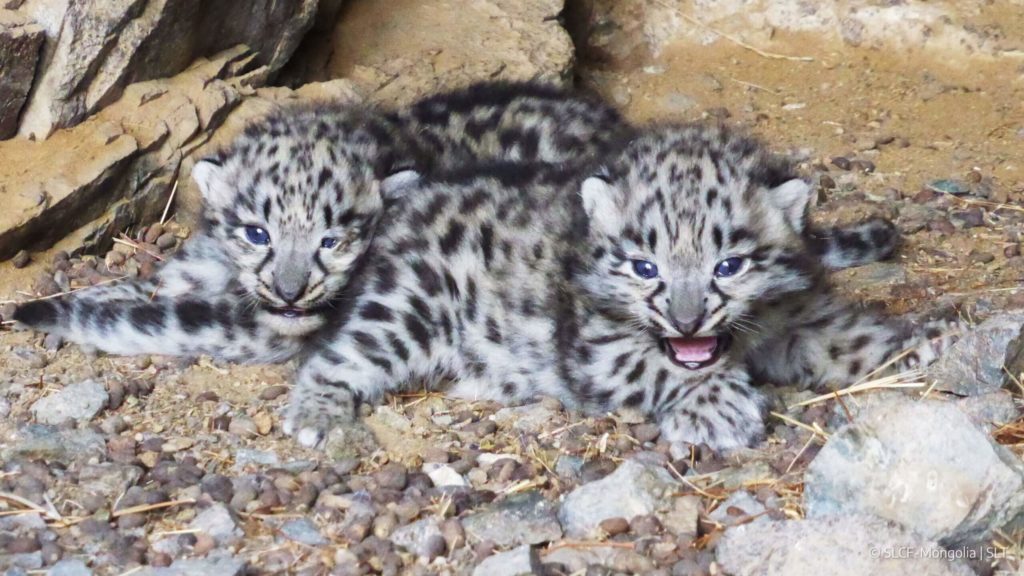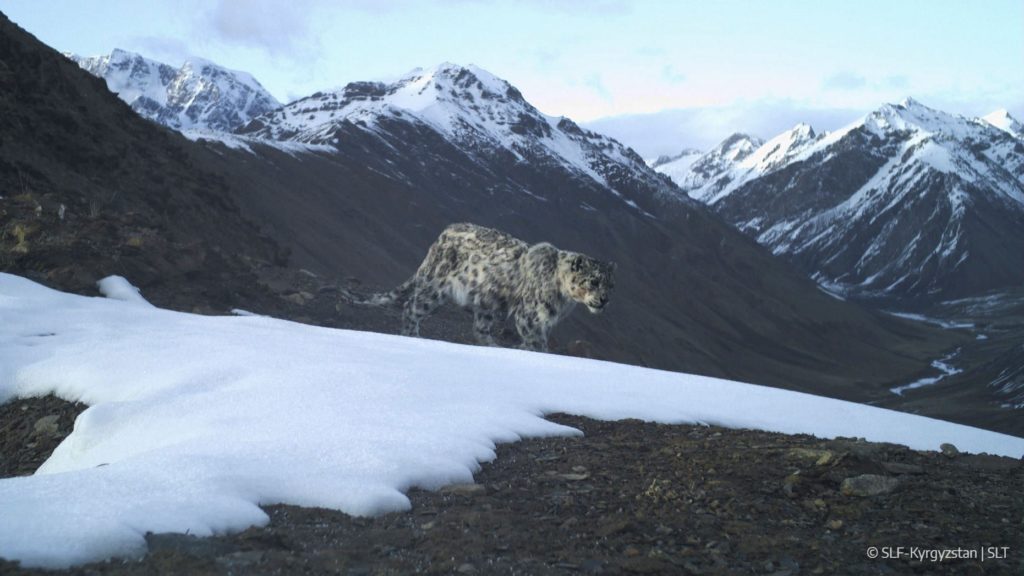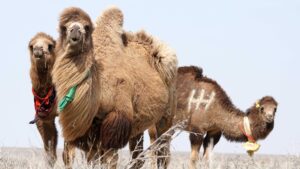Snow leopards – an exclusively Asian species of large mammals of the cat family – live on the territory of 12 countries: Kazakhstan, Kyrgyzstan, Uzbekistan, Tajikistan, Mongolia, Russia, Nepal, Pakistan, Myanmar, Bhutan, India, China. With the help of modern technologies, scientists are monitoring snow leopards’ behaviour and lifestyle to increase knowledge about this rare species to guarantee their survival.
“It’s not that simple” – so begins the answer to any question about the protection and preservation of snow leopards as a species. Are snow leopards categorised as vulnerable or endangered species? What is the biggest threat to their survival and reproduction? What is the best and most effective way to protect them? It’s not that simple, experts invariably answer.
This vague formulation is due to two peculiarities of the snow leopards’ lifestyle that complicate the possibility of observation: they live in high-mountainous and hard-to-reach places for humans, and they regularly traverse an impressive territory in search of prey. Snow leopards are strictly territorial animals, with males maintaining and regularly making rounds of their hunting territories, which can reach up to 1000 km² in area. Cases when leopards encroached on the territory of another representative of the species of the same sex are very rare.
Although these animals need a large territory, a scientific report published in 2016 by the Swedish Institute of Agricultural Sciences confirmed that almost 40% of all protected areas in the snow leopard’s range are too small to support even one breeding pair of these endangered cats. Specialists are convinced that for the species to survive in the wild, it needs a range sufficient for free movement of at least 50 breeding females.
Surveillance methods
The availability of such data and its accuracy have become possible in the last few years thanks to the developing technologies of animal observation. Wildlife cameras produce fascinating videos and photographs of animals, as well as documenting every single individual captured in a photo. Previously, in addition to camera shots, scientists have collected animal faeces to study the DNA of snow leopards. But both types of observing and studying had their significant limitations: it was impossible to trace the range of the animal’s hunting area, to find out what and when snow leopards eat, and how long they nurture and raise their offspring.

This is where a revolutionary development – collars with GPS trackers – comes to the rescue. Several non-profit organisations and foundations have begun implementing this technology in stages. One of them, Snow Leopard Trust, with the help of partner organisations and specialists, has managed to put the collars on several snow leopards in Pakistan, Kyrgyzstan and Mongolia. They track some of the animals since 2006.
“With the help of information from the collars, we learnt in which territories the animals move. One female with a collar travelled a distance of 2,000 kilometres during the time we monitored her. We would never have been able to capture that kind of information with cameras alone. We can also see how long [snow leopard] stays in one area and how often it changes its den,” said Kuban Jumabai Uulu, Director of the Snow Leopard Trust in Kyrgyzstan.
How collars with GPS trackers work
“For us, the process of fixing a collar on an animal is a combination of skill and art,” notes Koustubh Sharma, Science and Conservation Director at the Snow Leopard Trust.
Snow Leopard Trust Senior Scientist, Dr. Örjan Johansson, is the undisputed leader among researchers involved in the implementation and development of this technology. At the origin of this ambitious research project to study the living conditions and survival of snow leopards, he has managed to collar more than 30 snow leopards in Mongolia since 2006. So far, it is the southern part of the Gobi Desert, located in Mongolia, that serves as the main area of the scientific study involving collared wild cats.
To collar the leopards, experts study the routes of a particular animal and place a trap in its path. Once the trap is triggered, a team of scientists travel to the location and sedate the animal with a safe sedative. During the time the leopard is unconscious, the scientists carefully check the animal for any injuries, put a collar on it, and collect DNA samples – blood and hair – for further study. If an animal is trapped with any injuries, it is released without a collar.
Read more on Novastan: Still under threat – snow leopards in Kyrgyzstan
The Snow Leopard Trust is particularly proud of the latest advances in collar design – the current version of the device has an automatic release system. 18-20 months after the collar is attached, it falls off the animal’s neck automatically without human intervention. While the collar is active, scientists receive new data about the animal’s location every five hours. This information allows them not only to trace the routes of movement but also to better study the behaviour and habits of the animal. For example, if scientists notice that the animal spends a significant amount of time in one place, it is likely that it has found prey and is dealing with it. As soon as the snow leopard leaves a given location, scientists examine the remains of the feast and determine by the bones which animal became the victim of the predator.
The researchers had to make sure that such an invasive approach to animal studies did not have a lasting negative impact on the wild cats themselves. To that end, before launching the tracker collar programme in the wild, the experts put the collars on snow leopards at Seattle’s Woodland Zoo. Careful assessment of the animals’ behaviour before, during and after the experiment showed that the collars did not affect the leopards. The same results were obtained after removing the collars from free-ranging snow leopards.
Captivity vs. Freedom
At the moment, about 3000 snow leopards are kept in zoos around the world. They are scientists’ last hope in the most tragic scenario.
“It is important to realise that despite loud claims that snow leopards are no longer an endangered species, such claims cannot be made with 100 per cent certainty. We still have no way of stating the exact number of snow leopards living in the wild. The interval between our estimates is considerable. We should also keep in mind that the number of snow leopards in the wild continues to decline,” explains Koustubh Sharma.
The situation is ambiguous with keeping animals in captivity as well. These are not ideal conditions, and in the history of the species, there has never been a single case when a snow leopard born in captivity was able to integrate into its intended life in the wild. But if the number of free-living individuals continues to fall and the population of wild snow leopards wanes, all hope will fall on captive-born animals. They are the key to the preservation of the species and a guarantee of its survival.
The main threats and the fight against them
The situation is not getting simpler in this matter. Snow leopards have many enemies: global warming and climate change, poachers, reducing numbers of prey, but also the local population sometimes can kill or seriously injure wild cats while defending their territory and livestock. There are also known cases when snow leopards have become collateral damage in the fight against rodents and wolves with pesticides in the predator’s habitat.
Read more on Novastan: Climate change could lead to ever more fluctuated temperatures in Central Asia
The Global Programme for the Conservation of Snow Leopards and their Ecosystems in Kazakhstan estimates that snow leopards are exposed to all the above threats. The biggest threat comes from poachers, revengeful shepherds and lawbreaking hunters. Also, despite the existing numerous international and national laws and environmental acts, snow leopards are globally threatened with extinction due to insufficient implementation of these legal documents. Human activities that encroach on snow leopards’ habitat, as well as contributing to climate change, are increasingly reducing the territory already insufficient for the species’ prolific survival.

Nevertheless, foundations and NGOs are not despairing. Depending on the most widespread threats to the species’ survival in a particular country, organisations are developing programmes to address them. For example, in remote regions of India and Pakistan, where herders often kill snow leopards to protect their livestock, the Snow Leopard Trust offers financial compensation for lost farm animals. In Kyrgyzstan, Kuban Jumabai Uuly’s team rewards park rangers for every poacher caught, and conducts information classes about snow leopards for children and families living next door to the animal’s habitat.
All countries participating in the Global Programme for the Conservation of Snow Leopards and their Ecosystems, and more than 20 animal rights organisations supported an initiative called PAWS (Population Assessment of Snow Leopards in the World). The project was presented during the International Forum on the Protection of Snow Leopards and its Ecosystems in Bishkek in 2017; its main goal is to gain the most accurate estimation of the population of snow leopards in the wild.
In the meantime, every person interested in the conservation of the species can contribute in one simple way: familiarising themselves with the realities of snow leopards’ lives. Lack of knowledge among the local population and those authorised by the authorities is also one of the serious factors negatively affecting the living conditions of snow leopards.
Photos: Snow Leopard Trust
Preview collage: Perizat Suleiman
For more news and analysis from Central Asia, follow us on Twitter, Facebook, Telegram, Linkedin or Instagram.
 Saving Snow Leopards: how scientists fight for the survival of a species
Saving Snow Leopards: how scientists fight for the survival of a species 



